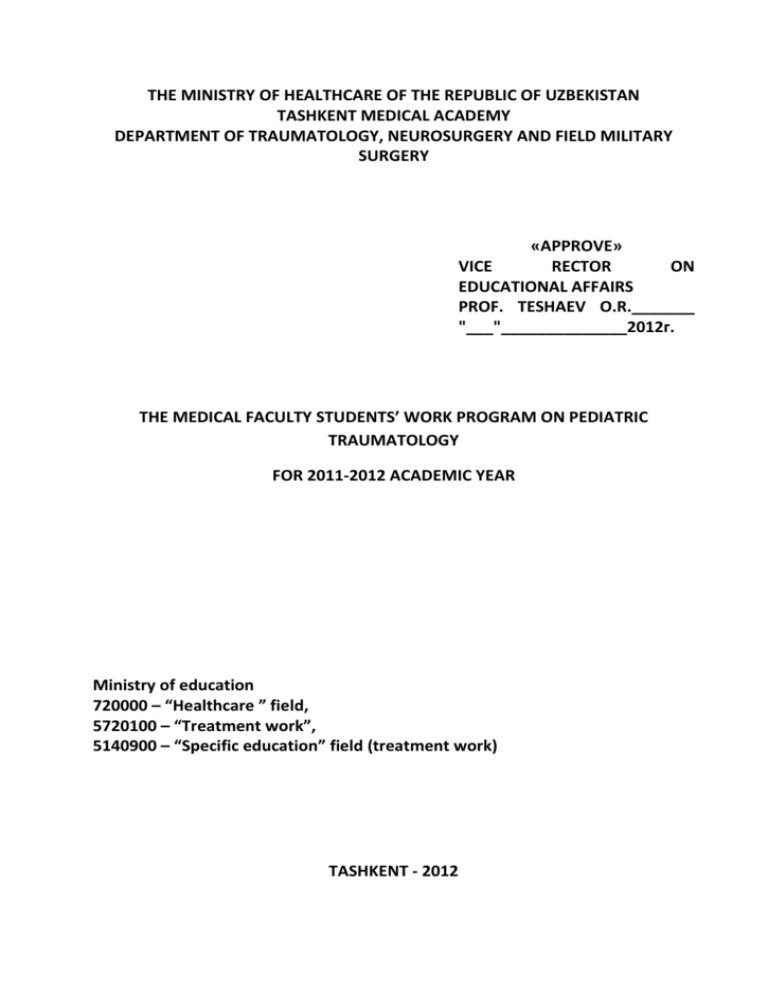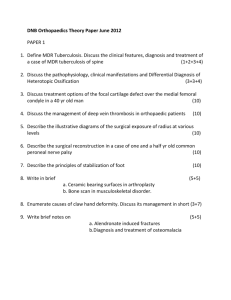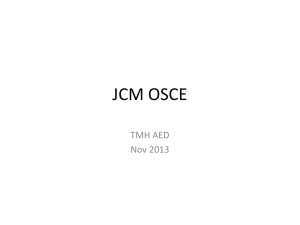Treatment work
advertisement

THE MINISTRY OF HEALTHCARE OF THE REPUBLIC OF UZBEKISTAN TASHKENT MEDICAL ACADEMY DEPARTMENT OF TRAUMATOLOGY, NEUROSURGERY AND FIELD MILITARY SURGERY «APPROVE» VICE RECTOR ON EDUCATIONAL AFFAIRS PROF. TESHAEV O.R._______ "___"______________2012г. THE MEDICAL FACULTY STUDENTS’ WORK PROGRAM ON PEDIATRIC TRAUMATOLOGY FOR 2011-2012 ACADEMIC YEAR Ministry of education 720000 – “Healthcare ” field, 5720100 – “Treatment work”, 5140900 – “Specific education” field (treatment work) TASHKENT - 2012 I. SUMMARY Pediatric trauma has the characteristic features of scientific and practical. The growth of child injury, increasing the proportion of heavy road accidents, which often leads to death or severe injury, causing great damage to society. Practice shows that the number of children affected with multiple associated injuries and non-continuously increasing. Despite the fact that data on injuries in children in domestic and foreign literature are not uncommon, many aspects of childhood trauma continues to attract attention. Analysis of a large number of children from the adverse effects of damage shows that many errors and complications are not careful initial examination of children, and particularly cases of polytrauma, gross mistakes in the provision of emergency assistance to them in the prehospital setting. II. GOAL AND TASKS The program aims to teach students diagnostic tactics and rehabilitation of children with injuries of the musculoskeletal system, providing outpatient care for children. As a result of the discipline, students should to know: 1. anatomy of the musculoskeletal system in children 2. especially fractures of the musculoskeletal system in children Be able to: 1. survey procedure childhood trauma patients. 2. Identify the main symptoms of the various trauma injuries. 3. primary care in traumatic injuries. 4. be able to diagnose children's polyclinic damage and identify indications for hospitalization trauma disorders. To be familiar: 1. the basics of primary care pediatric trauma patients. III. THE MAIN PRINCIPLES, METHODS AND TEACHING DEVICES Knowledge of the basic principles of pediatric trauma allow future general practitioners hold medical care trauma patients. Teaching should be carried out by students after passing a course in general surgery and trauma, which will facilitate learning. Theoretical knowledge must be supported by clinical as follows: interrogation of the patient; study to help trauma patients; study of laboratory tests and other advanced research methods of patient; formulation of initial diagnosis; filling in questionnaires outpatients; prepare a brief oral report on the analysis of the patient. Improving the effectiveness of learning requires integration with other scientific teaching units. It is clear that in the provision of training hours (18) pediatric trauma teaching program has limited space. To the success of training of general practitioners is particularly important issue of scientific information. Need to introduce students to the latest developments in the historical aspect of Traumatology. One of the important directions in the improvement of the educational process is the implementation of programmed training in pediatric trauma with the use of computer technology. Practical exercises are conducted in trauma wards and emergency room clinic. During employment should be fully utilized fragments educational films, slides, drugs, tables, simulation passes. Self-study is aimed at strengthening and deepening of the acquired knowledge, skills and abilities in pediatric traumatology. Only the creative activity and high autonomy will successfully learn complex material on pediatric trauma and improve the knowledge to practice. In independent work includes preparation for the presentation as "Power Point". To achieve the above objectives the student must during the cycle to perform the 3 to 4 manipulations between themselves and the sick. Working with plaster, prepare their own splints, plaster bandages under teachers and their overlap. Actively participate in the repositioning of fractures and dislocations reduction. Treating patients in the emergency department and be able to sort and provide first aid. The student should be able to end the cycle correctly diagnose, good to know the terminology and be able to provide first aid to trauma patients. III.1. THE NUMBER OF CONTROL ACTIVITIES TO ASSESS STUDENT KNOWLEDGE Knowledge students are evaluated by the current and final control: 1. Current control (TC) is implemented in each practical session (3 sessions). During the TC will be assessed theoretical knowledge in each class - 30% and practical skills (examination of the patient on the use of diagnostic equipment, interpretation of existing surveys, etc.) - 40%, and the decision at the end of each session of situational problems - 30 %. 2. The final control (IR) - is carried out on the final day, during which will assess the theoretical part on the topics of practical training (20%) ownership of practical skills (40%), assessment of supervised clinical records of patients (20%). IR is conducted in OSCE. III.2. NEW EDUCATIONAL TECHNOLOGY In order to improve the learning process and improve learning disciplines will use the following educational technology: • «The Weakest Link" • «The Cat in the bag" • «The handle on the table ' In addition will be the traditional teaching of technology: The training will be used: • Training videos; • Educational software; • Training and testing programs; • Library Foundation Chair. IV. Training facilities Base for teaching are the emergency room, emergency department and trauma surgery department of large joints and wrist clinics second TMA (two classes will be held on the basis of pediatric trauma TMPI). V. EDUCATIONAL PLAN Faculty GP Course VII Lectures 2 hrs Practical classes 18 hrs Semester XIII-XIV VI. THEMATIC PLAN OF LECTURES ON DISASTER MEDICINE FOR THE VII YEAR STUDENTS OF GP FACULTY TMA № Theme of the lecture 1 Features damage ODA in children Hours 2 Short Annotation Anatomical and morphological features of ODA in children. Characteristic lesions in children. Psychological aspects of the clinical examination in children. Terms fixation of fractures. Post-traumatic complications. VII. THEMATIC PLAN CALENDAR OF PRACTICAL CLASSES ON PEDIATRIC TRAUMATOLOGY FOR THE VII YEARS STUDENTS OF GP FACULTY № Theme of the lesson 1 Especially fractures of the chest, shoulders, upper limb in children 2 3 Features of spinal, pelvic, lower extremity in children Congenital and acquired deformities in children ODA Hours 6 6 6 Short Annotation of the theme Subperiosteal fractures. Epiphysiolysis and osteoepifizeolizy. Apofizeolizy. Fractures of the clavicle, humerus, forearm, hand bones. Diagnosis and treatment. Fractures of the femur. Damage to the knee. Fractures of the lower leg bones. Fractures of the foot and toes. Clinical features, diagnosis and treatment. Clinical, radiological symptomatology, diagnosis, and treatment policy. VII. List of educational aids and EQUIPMENT Movies in pediatric traumatology. Stands and posters, drawings and photographs. X-rays. CT and MRI. Dummies. Handout. Video on practical skills in pediatric traumatology. Virtual Library for pediatric trauma. Guidelines. CONTENTS TOPIC - 1. Especially fractures of chest, shoulders, upper limbs in children The increasing "epidemic of injuries," which entails our industrialized, mechanized and motorized age, covers an expanding wave, both adults and children. Among the total number of affected children is 25-30%, the mortality rate among them from injury in third place after the newborn pathology and respiratory diseases. Characteristically, among all pediatric surgical pathology damage are also about 25-30%. Lack of familiarity with the peculiarities of child injury, the specifics of childhood trauma, current traumatic disease in children today is unacceptable, it often leads to errors in diagnosis, and, consequently, incorrect treatment strategy will inevitably lead to complications and adverse outcomes. General characteristics, frequency and location. Fractures of the type of "green branches" or "rubber tube." Anatomical features of the structure of children's bones. Epiphysiolysis, osteoepifizeolizy, and epimetafizarnye epiphyseal fractures. Periarticular fractures, and osteoepifizeolizy perelomovyvihi. Cracked subperiosteal fractures epiphysiolysis, osteoepifizeolizy and apofizeolizy. Cracked and broken by the type of green branches or wicker. Apofizeoliz. Types of displacement of bone fragments and their characteristics. Rotary displacement. Axial displacement. Diagnosis of bone lesions in children. Treatment of closed fractures in children. Surgery of fractures in children shows. Fractures of the humerus. Kinds of damage to the proximal end of the humerus in children and their clinical manifestation. Over - and supracondylar fractures of the humerus. Complications of fractures of the humerus. Conservative treatment and methods for repositioning humeral fractures. Surgery of humeral fractures. Fractures of the forearm bones. Typical types of fractures and their clinical manifestation. Repositioning methods depending on the displacement of the radial head. Diagnosis of fracture and damage Montedzhi Brecht. Indications for surgery for fractures of the forearm bones. Fractures of the bones of the hand. Radiographic signs. Types of immobilization. TOPIC - 2. Especially fractures of the spine, pelvis, lower limbs in children Fractures of the femur. Kinds of damage to the femur in children with localization and their clinical manifestation. Types of immobilization. Methods of reduction. Surgery. Stages of treatment of children with fractures of the femoral shaft. Methods and types of traction. Complications of skeletal traction in children. Damage to the knee. Hemarthrosis. Intra-and periarticular fractures. Menisci. The clinical picture of traumatic dislocation of the patella. Conservative treatment of injuries of the knee. Surgery of the knee injury. Fractures of the lower leg bones. Kinds of damage to the lower leg. Epiphysiolysis osteoepifizeolizy and the proximal and distal ends of the tibia, diaphyseal fractures, avulsion intercondylar elevation - clinical picture, treatment. Fractures of the foot and toes. Fractures of the calcaneus and talus. The clinical picture. Treatment. TOPIC - 3. Congenital and acquired deformities in children ODA Dysplasia b / c of the joint. Junior epiphysiolysis femoral head. Stenosing ligamentity. Osgood-Shlyattera. Haglund disease-Sivertseva. Legg-Calve-Perthes disease. Varus and valgus deformities l / s, f / s. Anatomical and physiological and biomechanical characteristics. Clinical and radiological symptomatology and diagnosis. Treatment policy. LIST FOR FINAL QUIZ SOFTWARE PEDIATRIC TRAUMA 1. The main causes of child injury. 2. Lots of bones, through which the bone growth. 3. The typical damage in children. 4. Describe subperiosteal fractures. 5. What is epiphysiolysis. 6. Explain cracked and broken by type of green branches. 7. What is apofizeoliz. 8. Types of conservative treatment of fractures in children. 9. What is a rotating shift. 10.Tell us about the axial displacement. 11.What are the reasons for extending immobilize fractures in children. 12.Classification GA Bairova fracture of the humerus 13.The typical clinical picture with humeral fractures 14.Treatment for fractures of the humerus. 15.When is surgical treatment for fractures of the humerus. 16.Pronation dislocated radial head. 17.Tell Bennett fracture. 18.Damage to the knee. 19.Failure mechanism of the knee. 20.The clinical picture of a fracture of the femur. 21.Localization of fractures of the femur. 22.Tell a symptom of "sticky heels." 23.Treatment of fractures of the femur. 24.The clinical picture of traumatic dislocation of the patella. 25.The mechanism of fracture tibia. 26.Tibial fracture clinic. 27.The clinical picture of fractures of the talus. 28.The mechanism of fracture calcaneus. 29.Treatment for fractures of the calcaneus. 30.Name the reduction of traumatic dislocation of the humeral head on the author. 31.What are the most characteristic lesions elbow and forearm. 32.The main types of dislocation of the femur. 33.The clinical picture of traumatic dislocation of the femoral head. 34.Treatment of dislocation of the femur. 35.Tell causes pathological fractures. 36.What is an imperfect bone formation. 37.What recommendations do you know with frequent fractures accompanied by deformation of the limbs. 38.Diagnosis of pathological fractures. 39.Tell clinic and diagnosis of birth injury. 40.Tell treatment birth injury. TOPICS FOR INDEPENDENT STUDENTS TRAINING 1. 2. 3. 4. 5. 6. 7. 8. 9. Hematogenous osteomyelitis Drowning in fresh and salt water. Violation of posture. First aid for electrical accident. Myositis ossificans. Patrimonial damage to bones and joints in children. Post-traumatic rehabilitation of children. Osteochondropathy. Traumatic dislocations of the forearm in children. LIST OF PRACTICAL SKILLS Orthopedic examination of the patient First aid for fractures of the humerus Retention of limbs in the mid-physiological position "Orthopedic examination of the patient" 1. Indications: identification of deformation of the musculoskeletal system 2. Required tools: a well-lit room with natural light, a couch, stethoscope, protractor, measuring tape 3. Student job - Describe the deformation of the musculoskeletal system. 4. Information for examiners: Identify the knowledge and skills of students to vote separately on each of the below listed items № stepping through Finished 1 History and examination 2 Palpation and auscultation 3 Determination of the amplitude of active and passive movements of the joints using the protractor 4 Measurement of limb length and circumference measuring tape 5 Determination of muscle strength in 5 ballnoy system manual method 6 The diagnosis not fulfilled "First aid for fractures of the humerus" 1. Indications: closed and open fractures of the humerus 2. Required tools: Bus Cramer, 10.0 ml syringe, a vial of narcotic and non-narcotic analgesics, gauze bandages, cotton wool 3. Student assignment: tell a closed and open fractures of the humerus 4. Information for examiners: Identify the knowledge and skills of students to vote separately on each of the below listed items № stepping through 1 Figuring complaints, circumstances and the mechanism of injury 2 Patient survey (deformation, abnormal mobility, crepitus, function n.radialis) 3 Intramuscular injection of a narcotic or non-narcotic analgesics 4 Upper extremity fixation bus Cramer Finished Not fulfilled 5 transportation of the patient "Fixing the limbs in the mid-physiological position" 1. Indications: Determination of bone fractures and dislocations. 2. Required tools: ruler, measuring tape, protractor, pen. 3. Student job: Tell us about the axis of the limbs and medium-physiological corners fixing limb joints. 4. Information for examiners: Identify the knowledge and skills of students to vote separately on each of the below listed items № stepping through Finished 1 Middle-physiological angle for the ankle 2 Middle-physiological angle to the sacral 3 Middle-physiological angle for hip 4 Middle-physiological angle to the shoulder joint 5 Middle-physiological angle for beam joint 6 Middle-physiological angle for wrist RATING ON CHARTER PEDIATRIC TRAUMA № Points Evaluation The level of knowledge of the student Not Fulfilled Depending on the situation, to make the right decision and concludes. In preparation for practical training uses additional literature (both native and English). Essentially independently analyzes the problem of child injury. 1 Themselves can examine the patient and correct diagnoses and treatment plan assigns prevention of complications. 96-100 Shows high activity, creativity during interactive games. Correctly solve situational problems with full justification of the answer. During the discussion of the CDS is actively asking questions, making additions. Practical skill performs confidently, understand the essence. 2 In preparation for practical training uses additional literature (both native and English). Essentially independently analyzes the problem of child injury. Themselves can examine the patient and correct diagnoses and treatment plan assigns prevention of complications. Shows high activity, creativity during interactive games. Correctly solve situational problems with full justification of the answer. During the discussion of the CDS is actively asking questions, making additions. Practical skill performs confidently, understand the essence. 91-95 Essentially independently analyzes the problem of child injury. Shows high activity, creativity during interactive games. Excellent 3 86-90 «5» Correctly solve situational problems, justifies treatment is prevention plan. AFI knows musculoskeletal system, says confidently. There is an exact representation of the etiology, pathogenesis, clinical picture, can carry differential diagnosis, prescribe treatment, can take preventive measures. Practical skill performs confidently, understand the essence. Properly collect history, examines the patient, makes a preliminary diagnosis. Can interpret the data Ro "research. Actively involved in the discussion CDS. Shows high activity during interactive games. Correctly solve situational problems, but can not assign a specific treatment, confusing names corrective rods. AFI knows musculoskeletal system, says confidently. There is an exact representation of the etiology, pathogenesis, clinical picture, can carry differential diagnosis, prescribe treatment, but can not carry out preventive measures. 4 Practical skills to step through. 76-80 Properly collect history, examines the patient, makes a preliminary diagnosis. Can interpret the data Ro "research. Actively involved in the discussion CDS. Correctly solve situational problems, knows how to put on the classification of the clinical diagnosis, but can not assign a plan of treatment and prevention. 6 71-75 Good «4» 7 AFI knows musculoskeletal system, says confidently. There is an exact representation of the etiology, pathogenesis, clinical picture and differential diagnosis, but can not prescribe medication. Practical skill to perform, but confusing steps. Properly collect history, examines the patient, makes a preliminary diagnosis. Can interpret the data Ro "research. Actively involved in the discussion CDS. Correctly solve situational problems, but can not justify the clinical diagnosis. AFI knows musculoskeletal system, says confidently. There is an exact representation of the etiology, pathogenesis and clinical, but can not carry out differential diagnosis and prescribe treatment. 66-70 Properly collect history, examines the patient, but can not assess the severity. May partly interpret data Ro "research. Actively involved in the discussion CDS. 8 61-65 Satisfactor y «3» Making mistakes in solving situational problems (can not put a diagnosis on classification). Knows clinic injury, but said uncertainly. There is an exact representation of the mechanism of injury, but can not relate to the pathogenesis of the clinic. History was unfocused, inspection is not the scheme. Can not interpret the research data. Passive when discussing CDS. 9 55-60 10 54 -30 11 Has a general idea of the injuries to children, said not sure. Confuses AFIs musculoskeletal system. Alone can not interrogate and examine a sick child. Can not interpret the data Ro "research. Does not participate in the discussion of CDS. Bad Does not have an accurate picture of injuries to children. «2» AFI does not know of the musculoskeletal system. Very bad For the presence of the student in class, in due form, have a notebook, stethoscope. 20-30 «2» REFERENCES Main: 1. Isakov YR "Pediatric Surgery". M., Medicine 1983. 2. Bairov GA "Trauma of Childhood." L., 1996 3. Orthopedics childhood. Ed. M.V.Volkova and GM Ter-Egizarova. M., Medicine 1983 4. Jalilov PS Holhuzhaev M. "Bolalar travmatologiyasi." T., 1996 5. Damier NG Fundamentals of childhood trauma. RM 1960 6. Shaposhnikov JG Psychotherapy ortopediya.T-February 1997 More 1. 2. 3. 4. 5. Traumatology and orthopedics. H.A.Musalatov, G.S.Yumashev. 1995. Volkov MV Bone disease detey.-M.Meditsina, 1985. Dubrov Ya.G.Ambulatornaya travmatologiya.-M.: Medicine 1990. Krasnov AF Outpatient travmatologiya.-M.: Medicine 1986. A. Kaplan Damage to bones and joints. M.1983. Internet sites: www: travma.ru, www.histol chuvashia.com.; donhist. fromru.com.; medmir.ru; www.molbiol.ru; www.pediatrica.ru; sdo.psu.edu.ru; histology narod.ru; http://medic.med.uth.tmc.edu/Lecture/Main/Griff5.htm; www.wplus.ru; www.rezko.ru; catalog delovik.com. Зав. кафедрой, д.м.н. Каримов М.Ю.






